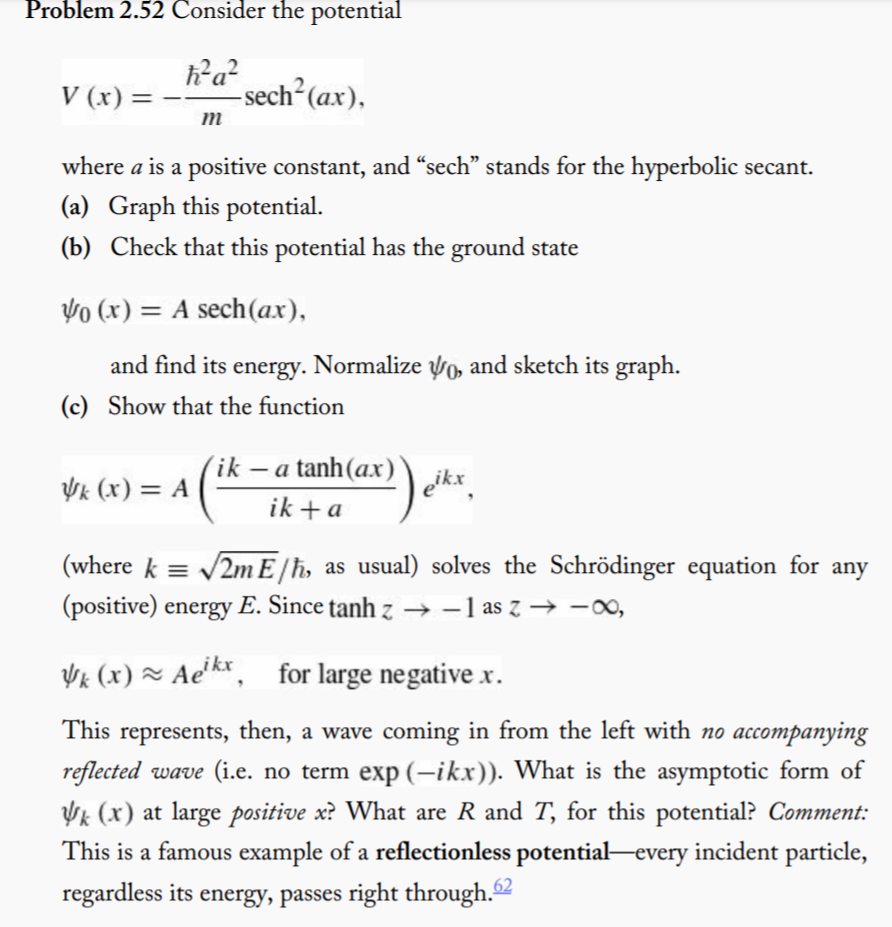Problem 2.52 Consider the potential V (x) : ka? -sech²(ax), m where a is a positive constant, and “sech" stands for the hyperbolic secant. (a) Graph this potential. (b) Check that this potential has the ground state Vo (x) = A sech(ax), and find its energy. Normalize vo, and sketch its graph. (c) Show that the function ´ik Yk (x) = A a tanh(ax) ik + a (where k = /2m E/h, as usual) solves the Schrödinger equation for any (positive) energy E. Since tanh z → -1 as z → -0, Vk (x) ~ Aekx, for large negative xr. This represents, then, a wave coming in from the left with no accompanying reflected wave (i.e. no term exp (-ikx)). What is the asymptotic form of Yk (x) at large positive x? What are R and T, for this potential? Comment: This is a famous example of a reflectionless potential–every incident particle, regardless its energy, passes right through.
Problem 2.52 Consider the potential V (x) : ka? -sech²(ax), m where a is a positive constant, and “sech" stands for the hyperbolic secant. (a) Graph this potential. (b) Check that this potential has the ground state Vo (x) = A sech(ax), and find its energy. Normalize vo, and sketch its graph. (c) Show that the function ´ik Yk (x) = A a tanh(ax) ik + a (where k = /2m E/h, as usual) solves the Schrödinger equation for any (positive) energy E. Since tanh z → -1 as z → -0, Vk (x) ~ Aekx, for large negative xr. This represents, then, a wave coming in from the left with no accompanying reflected wave (i.e. no term exp (-ikx)). What is the asymptotic form of Yk (x) at large positive x? What are R and T, for this potential? Comment: This is a famous example of a reflectionless potential–every incident particle, regardless its energy, passes right through.
Related questions
Question
Question related to

Transcribed Image Text:Problem 2.52 Consider the potential
V (x) :
ka?
-sech²(ax),
m
where a is a positive constant, and “sech" stands for the hyperbolic secant.
(a) Graph this potential.
(b) Check that this potential has the ground state
Vo (x) = A sech(ax),
and find its energy. Normalize vo, and sketch its graph.
(c) Show that the function
´ik
Yk (x) = A
a tanh(ax)
ik + a
(where k = /2m E/h, as usual) solves the Schrödinger equation for any
(positive) energy E. Since tanh z → -1 as z → -0,
Vk (x) ~ Aekx, for large negative xr.
This represents, then, a wave coming in from the left with no accompanying
reflected wave (i.e. no term exp (-ikx)). What is the asymptotic form of
Yk (x) at large positive x? What are R and T, for this potential? Comment:
This is a famous example of a reflectionless potential–every incident particle,
regardless its energy, passes right through.
Expert Solution
This question has been solved!
Explore an expertly crafted, step-by-step solution for a thorough understanding of key concepts.
This is a popular solution!
Trending now
This is a popular solution!
Step by step
Solved in 4 steps with 1 images

Knowledge Booster
Learn more about
Need a deep-dive on the concept behind this application? Look no further. Learn more about this topic, advanced-physics and related others by exploring similar questions and additional content below.